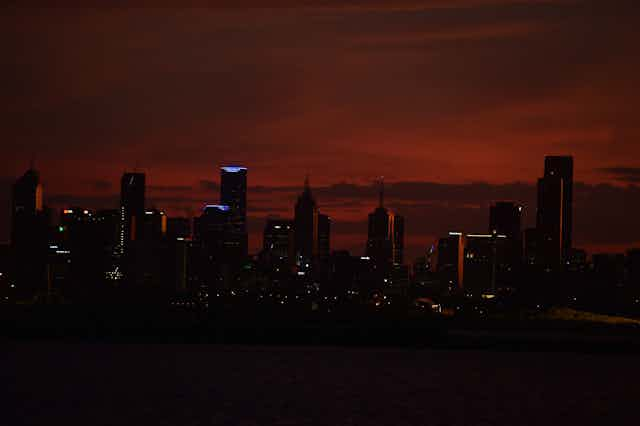Significant urban policy and planning efforts have been directed at the problem of rising heat in cities.
“Smart” cities create new relationships and interdependencies between people, technology and urban environments. The concept rests on the efficient, responsive and adaptive capacities of urban infrastructure. But how well does the smart city respond to the devastating scale and impact of urban heat threats such as bushfires and heatwaves?
The Australian Medical Association has warned heat is a “silent killer”. It notes that more Australians die each year due to heat than on the roads. Heatwaves have contributed to more deaths in Australia than any other natural disaster.
Bushfires are also expected to increase, with significant impacts on Australian cities and urban communities such as the greater Melbourne region.
This is a pressing issue for Australian cities and urban regions, at a time when Australian climatologists are warning of the increasing frequency, severity and duration of heatwaves and bushfires.
Smart urban infrastructure
New digital technology is entering cities, homes and workplaces. These are performing complex tasks. Self-driving cars and cashless payment systems are examples of significant change. But they also increase a city’s vulnerability in the event of a system breakdown or failure.
The ways that these dependencies make cities highly vulnerable during a crisis are poorly understood. For example, smartphone-enabled bushfire and heatwave warning systems are one of the key policy responses proposed and trialled as part of the smart city. But, the benefits and challenges of such responses are still largely unknown.
While the invisibility of smart city technology and infrastructure may rise to the surface and become exposed in the face of urban heat-related threats and crises, an array of important considerations lurk in the shadows.
These include financial arrangements, decision-making processes and discussions about security that are often imbued with statutory power, force and intent that work to inform and structure the experience of everyday urban life.
System resilience or collapse?
Smart systems are far from resilient. Outside their design range they are prone to sudden collapse. Any failure in energy or IT systems can lead to cascading crisis in the capacity for smart city responses to heat threats and disasters.
In a heatwave, as demand increases for cooling mechanisms such as air conditioning and refrigeration, an overloaded system may break down.
The rapid expansion of mobile and computer warning and alert systems could keep people more aware of risks. But, it also creates dependencies and a reliance on external agents for tasks we currently manage. The relationship between emergency communication processes and protocols is a key area whereby vertical, authorised and often-slow communications must interact with horizontal, real-time, networked and participatory processes.
The royal commission into Victoria’s Black Saturday bushfires recommended that more efficient and effective use of technology was needed in key areas such as fire risk assessment, tracking and monitoring – particularly when different, incompatible systems were in use.
The commission highlighted widespread problems with communication technology, use and access due to system incompatibility, poor coverage, radio black spots and channel congestion. Under-investment in new technology was exacerbated when fire damaged or destroyed critical radio and telecommunications infrastructure.
An urgent cities agenda
Urban heat threats and disasters have an impact on the critical infrastructure that undergird the smart city response to such disasters and their associated technology, infrastructures and networked systems – namely in the areas of energy, water, ICT and transport.
The impacts are felt predominantly by those most vulnerable in the community: children, the elderly, the poor and people with existing health conditions.
Understanding the dynamism and tension of new technologies, networks and infrastructure is critical, particularly when urban systems are threatened or break down. Despite recognition of the complexity in smart city debates, policy and industry commentary places clear demarcations between the social and the technical.
There is an urgent need to develop new understandings and ways of implementing the potentials and possibilities the smart city presents in order to better tackle urban heat threats and disasters in Australia.

